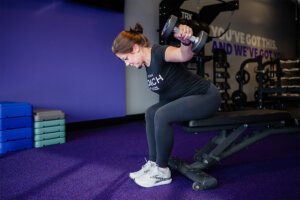The best thing about cycling for exercise is that it can be whatever you want it to be. Whether you’re looking for a casual recovery day or a fast-paced cardio ride that will leave you dripping with sweat, cycling can do both, and it’s a great way for people of all fitness levels to get a good workout.
Unlike the treadmill, cycling is a low-impact workout, meaning it’s gentle on the joints and can benefit people of all ages. Both a professional athlete and someone who hasn’t exercised in 30 years can hop on the same exact bike and get a workout that fits their needs. Even if you are a runner at heart, hopping on the stationary bike for some cardio can give your joints a break from the repetitive impact that running, jogging, and walking put on the body.
Sounds great, right? But before you jump on a stationary bike, let’s talk about pacing.
In order to get the most out of your workout, it’s important to understand pacing and resistance. Similar to other cardio machines, biking allows you to control your speed and resistance, which are the two primary ways of changing the intensity of your workout. Your speed is entirely dependent on you and how fast you pedal, which is why it’s important to stay focused and challenge yourself — otherwise, you’ll find your speed dropping! The other way to add intensity to a workout is resistance. Most bikes allow you to adjust the resistance — that is, how hard you have to pedal to get the bike to move — using a knob somewhere below the display. By adding resistance, you force your muscles to work harder to get the wheel to spin. Even if you’re going for a speed workout, you’ll still want to add a little resistance in order to keep the bike and yourself stable.
If you haven’t used a stationary bike before, it might be a good idea to hop on and play around to get comfortable with the bike. Once you know what speeds and resistance levels will challenge you, it’s easy to build a workout that fits you.
For this workout, we’ll utilize four different levels of intensity. If that seems like a lot, remember that you can play with not only the speed, but the resistance, too. Take a few minutes before starting the workout to explore what your four paces will be!
Base – A pace that you could maintain for 30 minutes straight if you needed to
Burn – A challenging pace that you could maintain for four or five minutes before needing a break
All Out – A very challenging pace you could maintain for about a minute before needing a break
Recovery – A relaxed pace that lets you recover without stopping the pedals
The Workout
Once you have a good understanding of the four paces above, and what combination of speed and resistance works well for you, it’s time to bike! Start a timer and watch it closely — this workout will be done before you know it.
(0:00) 3 Minute Base
(3:00) 2 Minute Burn
(5:00) 2 Minute Base
(7:00) 1 Minute Burn
(8:00) 30 Second All Out
(8:30) 90 Second Recovery
(10:00) 1 Minute Base
(11:00) 2 Minute Burn
(13:00) 1 Minute Base
(14:00) 1 Minute All Out
(15:00) 1 Minute Recovery
(16:00) 1 Minute Base
(17:00) 1 Minute Burn
(18:00) 1 Minute Base
(19:00) 1 Minute All Out
Post Workout
Phew! You’re done and you crushed it! How did that feel? Will you have to adjust any of your paces for next time? Take a few minutes to bike at your recovery pace and let your heart rate come down, and remember to grab some water and refuel after a great workout.



